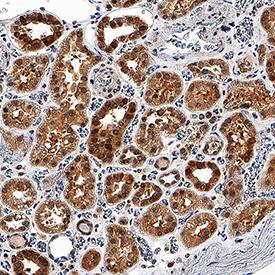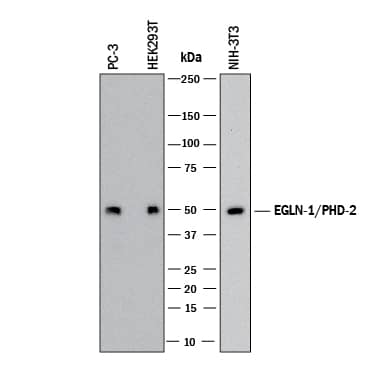Human/Mouse EGLN1/PHD2 Antibody
R&D Systems, part of Bio-Techne | Catalog # MAB76801

Key Product Details
Species Reactivity
Applications
Label
Antibody Source
Product Specifications
Immunogen
Ala2-Phe426
Accession # Q9QZT9
Specificity
Clonality
Host
Isotype
Scientific Data Images for Human/Mouse EGLN1/PHD2 Antibody
Detection of Human and Mouse EGLN1/PHD2 by Western Blot.
Western blot shows lysates of PC-3 human prostate cancer cell line, HEK293T human embryonic kidney cell line, and NIH-3T3 mouse embryonic fibroblast cell line. PVDF membrane was probed with 1 µg/mL of Rabbit Anti-Human/Mouse EGLN1/PHD2 Monoclonal Antibody (Catalog # MAB76801) followed by HRP-conjugated Anti-Rabbit IgG Secondary Antibody (Catalog # HAF008). A specific band was detected for EGLN1/PHD2 at approximately 50 kDa (as indicated). This experiment was conducted under reducing conditions and using Immunoblot Buffer Group 1.EGLN1/PHD2 in Human Kidney.
EGLN1/PHD2 was detected in immersion fixed paraffin-embedded sections of human kidney using Rabbit Anti-Human/Mouse EGLN1/PHD2 Monoclonal Antibody (Catalog # MAB76801) at 3 µg/mL for 1 hour at room temperature followed by incubation with the Anti-Rabbit IgG VisUCyte™ HRP Polymer Antibody (Catalog # VC003). Before incubation with the primary antibody, tissue was subjected to heat-induced epitope retrieval using Antigen Retrieval Reagent-Basic (Catalog # CTS013). Tissue was stained using DAB (brown) and counterstained with hematoxylin (blue). Specific staining was localized to cytoplasm and nuclei in convoluted tubules. View our protocol for IHC Staining with VisUCyte HRP Polymer Detection Reagents.Applications for Human/Mouse EGLN1/PHD2 Antibody
Immunohistochemistry
Sample: Immersion fixed paraffin-embedded sections of human kidney
Western Blot
Sample: PC‑3 human prostate cancer cell line, HEK293T human embryonic kidney cell line, and NIH‑3T3 mouse embryonic fibroblast cell line
Formulation, Preparation, and Storage
Purification
Reconstitution
Formulation
Shipping
Stability & Storage
- 12 months from date of receipt, -20 to -70 °C as supplied.
- 1 month, 2 to 8 °C under sterile conditions after reconstitution.
- 6 months, -20 to -70 °C under sterile conditions after reconstitution.
Background: EGLN1/PHD2
PHD2 (Prolyl Hydroxylase Domain-containing protein 2; also HPH2, EGLN1 and HIF-PH2) is a 45-47 kDa dioxygenase member of the PH family of enzymes. It is ubiquitously expressed, and serves to regulate the availability of the oxygen-sensitive HIF transcription factor. Active HIF1 alpha is a heterodimer of alpha- and beta-subunits and when intact, promotes VEGF and EPO production. The beta-subunit is constitutively expressed, while alpha-subunit levels are regulated by intracellular oxygen concentration. At normoxic levels, the alpha-subunit is hydroxylated on Pro by one of three PHDs, inducing its ubiquitination/degradation. The hydroxylation event requires oxygen, and thus PH activity (particularly PHD2) is a measure of a cell's oxygen concentration. Human PHD2 is 426 amino acids (aa) in length. It contains an NES (aa 6-20), a Zn-finger region (aa 21-58), and a catalytic domain (aa 291-392). There are five nitrosylated cysteines plus one acetylated alanine. Two isoform variants are known, one that shows a deletion of aa 338-359, and another that contains a 17 aa substitution for aa 58-175. Over aa 157-426, human PHD2 shares 93% aa sequence identity with mouse PHD2.
Long Name
Alternate Names
Gene Symbol
UniProt
Additional EGLN1/PHD2 Products
Product Documents for Human/Mouse EGLN1/PHD2 Antibody
Product Specific Notices for Human/Mouse EGLN1/PHD2 Antibody
For research use only

